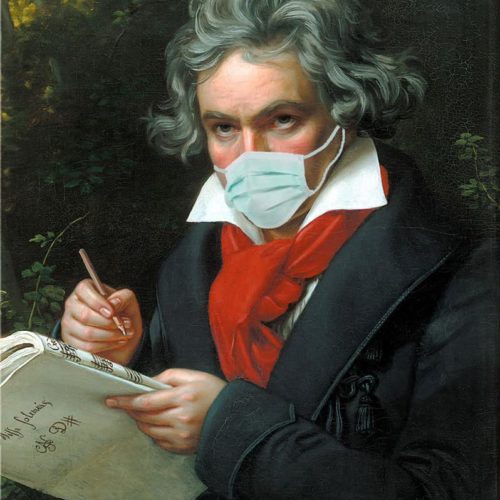Welcome to the 45th work in the Slipped Disc/Idagio Beethoven Edition
Violin sonatas nos 4-8, opus 23-24 and opus 30/1-3 (1801-2)
Beethoven’s deafness was a slow, painful affair that progressed in three stages. The composer first complained of hearing difficulties in 1798 and sought medical attention, which proved useless. In July 1801, when he was just 30 years old, he wrote to a friend: ‘Know that my noblest faculty, my hearing, has greatly deteriorated. I beg you to keep the matter of my deafness a profound secret to be confided to nobody, no matter whom.’
Ignorant of science and the workings of the human body, he ascribed the condition initially to his stomach aches and digestive problems. One doctor advised cold baths, which only worsened his mood. The symptoms he describes suggest a form of tinnitus, a ringing or roaring in his ears. Modern diagnosticians offer an alternative condition known as labyrinthitis, a lesion on the inner ear, possibly of syphilitic origin.
Whatever the cause, by mid-1801 Beethoven had lost 60 percent of his hearing and much of the rest by October 1802 when he wrote the heart-rending Heiligenstadt Testament to his brothers, outlining his plight and hinting at thoughts of suicide. ‘You who think or say I am malevolent, stubborn or misanthropic, how greatly you wrong me for you do not know the secret causes … For six years I have been a hopeless case, aggravated by senseless physicians, cheated year after year in the hope of improvement, finally compelled to face the prospect of a lasting malady (whose cure will take years or, perhaps, be impossible). Born with an ardent and lively temperament, even susceptible to the diversions of society, I was compelled early to isolate myself, to live in loneliness.’
Beethoven’s describes his survival strategy as self-isolation, a term that has become all too familiar in recent weeks.
By 1816 he was completely deaf, cut off from the world of sound. His only remaining form of communication was through a notebook in which he scribbled thoughts and instructions, sometimes gathering friends around him in a café to exchange ideas on paper. His isolation was aural more than social. However given that he relied on sound to make sense of the universe, his isolation was, if anything, psychologically more severe than bodily quarantine.
The two dates of self-diagnosis and total deafness, 1801 and 1816, coincide with decisive shifts in Beethoven’s evolution as an artist. The first marks the onset of what is known as his middle period, with the onrush of terror and sorrow channelled in the Eroica Symphony. The second date marks the start of late Beethoven, his immersion in the spiritual conundra of the meaning of life on earth. Franz Schubert saw him once in an inn, jotting a word here and there in a notebook. Just words, he observed. The notes, said Schubert, came later. Process, in Beethoven, differed from all other composers, in part because he was isolated by deafness from the rest of humanity.
Between losing his hearing in July 1801 and the Heiligenstadt Testament 15 months later his output is dominated by five violin sonatas, an instrument with which (as we’ve seen) he had no intense emotional engagement. Was he on top form in this set? Although well received, the violin-piano were not greeted with the respect accorded to his symphonies, or the sense of expectation that awaited his piano sonatas. It is not until the 21st century that the violin sonatas receive scholarly attention as a body of work, and the results are not uniformly illuminating. The sonatas are almost stepchildren beside the brilliance of his contemporary works.
Take the fourth sonata, which hardly leaps off the page. The opening movement keeps going round and round the same theme without making much obvious headway. You are halfway into the finale before Beethoven touches heart and mind. There’s an engaging 1944 recital by Joseph Szigeti and Claudio Arrau, a defiantly nonchalant 1952 take by Jascha Heifetz and Emanuel Bay and a white-gloved presentation by from Wolfgang Schneiderhan and Wilhelm Kempff. My inclination in these sonatas is to go first to Itzhak Perlman and Vladimir Ashkenazy (1977), where flashes of ice and fire hold the attention in the dry patches. You should also not overlook the 2011 dialogue of Pamela and Claude Frank, a vigorous conversation in which the daughter’s American can-do locks horns with the father’s Germanic conservatism.
The fifth sonata, titled Spring, opens with a courageous attempt by Beethoven to surmount his circumstances with a simulation of the joys of nature coming to life after winter, an anticipation of his Pastoral Symphony. The second movement, an adagio, suggests a young person falling in love. The Austrian-Jewish violinist Erika Morini was 23 when she played this 1927 Berlin recording with the pianist Miklos Schwalb and her sensual awakening is so vivid as to be almost overwhelming.
Morini’s antithesis is Rudolf Kolisch, Austrian brother-in-law of Arnold Schoenberg and a foot-soldier in his atonal revolution. Kolish, who was 70 at the time of this 1966 session with pianist Gunnar Johansen, plays with a fastidious concern for precision ans structure, reimagining the sonata in an absolutely fascinating way as a prelude to some undefined progressive ideology. I love what he does with it, as much as I love Morini falling in love. Both violinists, by the way, wound up exiles in America.
Other than the big-name violinists, all of whom recorded this popular piece, I would further direct your attention to Morini’s second take in 1961 with the Czech pianist Rudolf Firkusny, a gentle, reflective courtship between two people who have been hurt in love – and to the husband-and wife 2002 pairing of Augustin Dumay and Maria João Pires, a beautiful affirmation of enduring love.
The 6th sonata is an Eroica-in-progress, sharing hints of symphonic development but no unique character of its own until the slow middle movement. Perlman and Ashkenazy find an original pattern in the piecemeal nature of the work. James Ehnes and Andrew Armstrong (2017) achieve a greater serenity.
Sonata number 7 goes for dramatic power. There’s a particularly affecting 1956 account by Arthur Grumiaux and Clara Haskil, with a finale that flirts with ominous outcomes.
The 2014 Dutch pair Hannes Minnaar and Isabelle van Keulen have a different chemistry, with a softer landing. If you prefer bumpy and without seat-belts, there’s Ruggiero Ricci and Friedrich Gulda (1954).
The 8th sonata is the most folkloric of the set, with hints of raspberry, mushrooms and woodland smells. Dumay and Pires are havng a private picnic. Isabelle Faust and Alexander Melnikov can’t wait to catch the bus home. My favourites, for gentle pace and thoughtful deliberation, are Henryk Szeryng and Ingrid Haebler.




